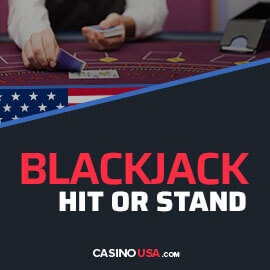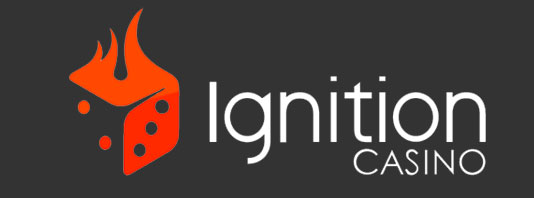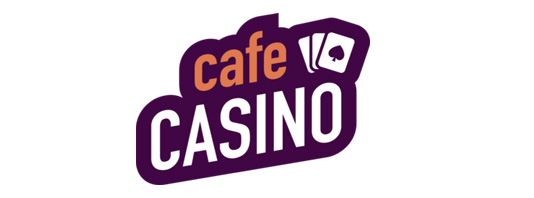- Slots
- Blackjack
- Roulette
- Live Dealer
- Baccarat
- Great selection of slots
- High-quality live dealer games
- Excellent welcome bonus
- Crypto-friendly
- Slots
- Blackjack
- Roulette
- Live Dealer
- Baccarat
- 300+ games
- Crypto-friendly casino
- Live dealer jackpot
- Bonus galore for different verticals
- Slots
- Blackjack
- Roulette
- Live Dealer
- Baccarat
- Accepts cryptocurrencies
- Generous welcome bonus
- Loyalty program
- Kahnawake Licence
We will debunk the biggest mystery in blackjack — when to hit and stand based on your hand totals.
What Do Hit and Stand Actions Mean in Blackjack?

After you’re dealt the initial two cards in blackjack, you’ll be presented with several playing actions based on the format of the game. Hit and stand are the most important ones, and each involves the following:
- Stand — When you stand in blackjack, you’re refusing to take any more cards and holding your total. This means that you’re confident that your hand will beat the dealer during the showdown.
- Hit — Hit is the exact opposite of stand. By hitting, you’re asking for an additional card to improve your total and your chances against the dealer’s hand. You can opt to hit for as long as you don’t go bust (exceed 21).
Mathematically, it makes sense to stand if your total is high (close to 21) and hit when your hand is of low value.
However, things are not so black and white because there are external factors to consider. These include the number of decks and house rules (whether the dealer hits or stands on soft 17).
Hand composition (the concept of soft and hard hands) is also important. Soft hands are those that comprise an ace, while hard hands are made of other cards.
Side bet availability should also be factored in (for example, surrender is an advisable action when the dealer’s up card is an Ace or 10).
Decisions on whether to hit or stand are outlined in the basic strategy, which can be helpful, especially if you’re a beginner.
Learn When To Hit or Stand in Blackjack
When to Hit
![]() Hitting in blackjack means that you’re instructing the dealer to give you one extra card.
Hitting in blackjack means that you’re instructing the dealer to give you one extra card.
One of the must-hit scenarios is when the dealer’s up card is an ace. In those situations, there is a greater chance for them to land a blackjack or a total that’s close to it. Therefore, you need a strong hand to match — preferably 17 or higher.
Likewise, if the dealer is showing a high-value card (7, 8, 9, 10), an appropriate move is to hit until you reach a total of 17 or higher. When you hold 11 or less while the dealer has 4,5, or 6, you should hit (or double down).
If the dealer’s up card is 2 or 3 and you’re in possession of 12 or lower, you should hit. Otherwise, standing is a more rational decision.
When to Stand
![]() By indicating you want to stand, you are basically asking for a showdown with the dealer, confident that you can beat him with your total. The basic strategy implies that you should stand on totals of 17, 18, 19, and 20, regardless of what the dealer has.
By indicating you want to stand, you are basically asking for a showdown with the dealer, confident that you can beat him with your total. The basic strategy implies that you should stand on totals of 17, 18, 19, and 20, regardless of what the dealer has.
As for 16, there is no set rule on what to do, as it all depends on the hand composition. If it’s a hard 16, then there’s not much you can do to improve your odds, so it doesn’t really matter whether you stand or hit — you’re likely going to lose anyway.
If you have good totals that can be split, then you should do that instead of standing. For instance, 9–9 and 10–10 can form two good hands.
In situations where you’re holding 12 or higher while the dealer’s up card is 4, 5, or 6, you should stand because the likelihood of the dealer forming a blackjack with those cards is small.
Similarly, you should stand on 13 or higher if the dealer shows 2 or 3.
Impact of Soft and Hard Hand Totals
Blackjack experts and mathematicians have devised a “blackjack hit table”, which shows you when to hit and when to stand depending on your and the dealer’s total and the respective hand compositions.
Here’s how the chart looks when you’re dealt a hard hand:
| Player | Dealer | Action |
|---|---|---|
| 5–8 | Any | Hit |
| 9 | 2, 7–ace | Hit |
| 9 | 3–6 | Stand |
| 10 | 2–9 | Stand |
| 10 | 10, ace | Hit |
| 11 | 2–10 | Stand |
| 11 | Ace | Hit |
| 12 | 4–6 | Stand |
| 12 | 2,3; 7–ace | Hit |
| 13–16 | 2–6 | Stand |
| 13–16 | 7–ace | Hit |
| 17–21 | Any | Stand |
When it comes to soft hands, the situation is much more straightforward. Here are a few pointers to have in mind:
- Always stand on soft 19 or 20
- Stand when you have soft 18 against the dealer’s 2–8
- If the dealer shows 9–ace, you should hit on a soft 17 or less
Blackjack Hit or Stand Charts
Looking for hit or stand charts for a specific game? Use the links below to select your chart.
- Single Deck Blackjack
- Multi-Deck Blackjack
- Atlantic City Blackjack
- Double Attack Blackjack
- Blackjack Switch
- European Blackjack
- Perfect Pairs Blackjack
- Zappit Blackjack
Conclusion
Learning when to hit and stand is the cornerstone of the basic strategy in blackjack. When you master it, you’ll be able to bring down the house edge to the coveted 0.5% and gain as much value from your sessions as possible. With the help of techniques like card counting, you can reduce the house edge even further.
The decision of whether to hit or stand is casino and variant-specific and also depends on some other factors. That’s why it’s recommendable that you try the demo mode (offered in RNG-based blackjack variants) before taking the plunge with real money action.
In the event you are ready to put your knowledge into practice, we can recommend a few great blackjack sites for you to check out.
FAQ
- 21+3 Blackjack
- 6:5 Blackjack
- Advanced Strategy
- Atlantic City Blackjack
- Blackjack Bankroll Management
- Blackjack Etiquette
- Blackjack for Beginners
- Blackjack Odds and Probability
- Blackjack Soft Hands
- Blackjack Strategy Simulator
- Blackjack Switch
- Blackjack Terminology
- Blackjack Tournaments
- Blackjack vs. Pontoon
- Blackjack: Online vs. Offline
- Bonus
- Card Counting
- Card Counting Hi-Lo
- Dealer’s Up Card
- Double Attack
- Double Down
- Double Exposure Blackjack
- European
- Face-Up vs. Face Down
- Hard vs. Soft Hands in Blackjack
- Hole Carding
- House Edge
- How to Win
- How to Win Live Blackjack
- Insurance
- Is Online Blackjack Legal in the US?
- Lucky Ladies Side Bet
- Mobile Blackjack
- Multi Deck
- Online Blackjack Rigged
- Online Blackjack vs. Live Blackjack
- Online Strategy
- Perfect Pairs
- Power Blackjack
- Progressive Betting
- Real Money Blackjack
- Rules
- Side Bets
- Single Deck
- Soft 17 in Blackjack
- Spanish 21
- Splitting
- Strategy
- Strategy Charts
- Surrender
- Variations
- Zappit



